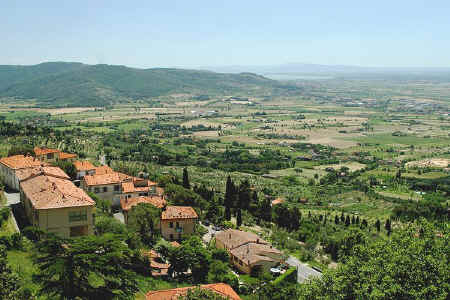|
The
Val di
Chiana (Valdichiana)
was extensively settled by the
Etruscans
and Romans. Because of the low river and steam gradients, deforestation resulted in silt accumulation and the
valley of the River Chiana slowly became an extensive marshy area. Malarial infestation began in Etruscan times and became seriously
hazardous during the Middle Ages and Renaissance when the wetlands were
as much as 140 sq km in area. Drainage was first proposed during the 14 C and by 1500 land reclamation was taking place. A man-made channel, the
Canale Maestro, was dug to reverse the direction of water flow from southward into the Tiber to northward into the Arno. This work was completed in 1840. Tributary streams were also canalised so that the area is now a fertile alluvial valley. The present-day appearance of the Val di Chiana is
thus the result of marsh drainage and reclamation work that was started by the Romans and carried on right through to the
20 C. Leonardo da Vinci drew a map of the area at the beginning of the
16 C, that shows the valley occupied by a large lake running
north-south. The towns and villages in the hills on either side of the lake communicated by means of
a ford at Valiano, a small village that still
exists. There are now just two remnants of the original large lake, the Lago di Chiusi and the very small lake at
Montepulciano.
The
Val di Chiana extends over the territory of 22 municipalities in
the provinces of Arezzo and Sienna in Tuscany, as well as of
Perugia and
Terni in
Umbria. From the north, the valley runs southwards from Arezzo
and westwards of Cortona,
both of which have magnificent views over the plains of the
valley floor. The Val di Chiana thus lies between between the Val d'Orcia and the Val Tiberina
(Tiber valley)
below Perugia,
where the Upper Tiber Valley begins. To the north is the
Siennese Chianti and part of the Val d'Elsa. The much hillier
Val d'Orcia lies to the west of Montepulciano, across a ridge
that starts with Monte Cetona in the south. As throughout the region, Sienna and Florence fought for control of
the Val di Chiana on a number of occasions.
|
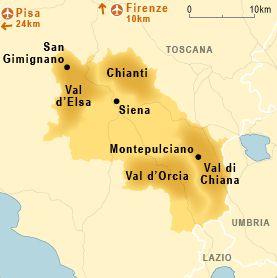
Province
of Sienna, Tuscany
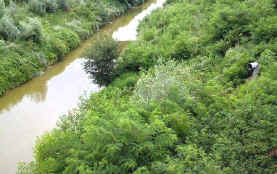
Canale Maestro
|
|
The valley may be divided into three zones:
the Aretine
(i.e. of Arezzo) Val di Chiana, the Siennese Val di Chiana, and the
Roman
Val di Chiana.
|
Aretine Val di Chiana (Valdichiana aretina)
This
is the part of the Province of Arezzo covered
by the municipalities of:
Arezzo
(partly)
Castiglion Fiorentino
Civitella in Val di Chiana
Cortona
Foiano della Chiana
Lucignano
Marciano della Chiana
Monte San Savino
These are municipalities that were already under the control of the
Medici in 1554, the year of the Battle of Scannagallo after which the
Florentines occupied the entire valley. The Aretine Val di Chiana lies
at the convergence of the four historical valleys of the province of
Arezzo together with the Valtiberina, the Casentino (Upper Val d'Arno)
and the Valdarno itself.
Siennese
Val di Chiana (Valdichiana
senese)
This
is the part of the Province of Sienna covered
by the municipalities of:
Cetona
Chianciano Terme
Chiusi
Montepulciano
San Casciano dei Bagni
(partly)
Sarteano
Sinalunga
Torrita di Siena
Trequanda
These are municipalities that were part of the Siennese Republic until
1554. With the exception of San Casciano dei Bagni, all of these
municipalities formed part of the aretine territories of the Grand Duchy
of Tuscany after 1554. With the unification of Italy in 1860, they were
re-allocated to the province of Sienna.
Roman
Val di Chiana (Valdichiana romana)
"Roman"
Val di Chiana refers to the territory of five municipalities in Umbria.
Three of these are in the province of Perugia
Castiglione del Lago
Tuoro sul Trasimeno (partly)
Cittΰ della Pieve
and two are in the province of Terni:
Monteleone d'Orvieto
Fabro
|
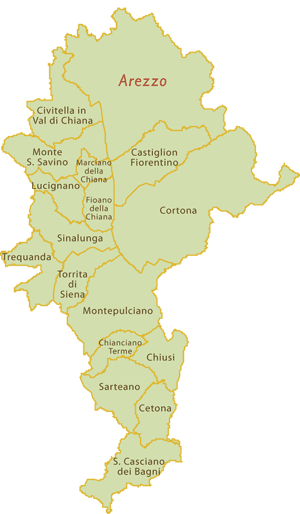
|
|
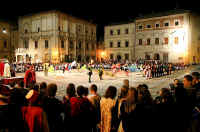 |
Montepulciano is
the largest municipality in the Siennese Val di Chiana. A long, winding street called the Corso climbs up to the main
piazza at the summit of the hill. The town is encircled by fortifications
and, inside, there are numerous beautiful Renaissance palazzi and
churches. Montepulciano is chiefly known for its
"Vino
Nobile di Montepulciano" wines. The Bravμo delle Botti
(barrel rolling race) takes place on the
last Sunday in August.
More about Montepulciano
|
|
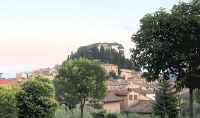 |
Cetona
is a well-preserved mediaeval town situated in the Val
di Chiana in the extreme south-east of Tuscany, in the province of
Sienna. It surrounds a hill where the rocca (fortress), containing a square tower (ca 900 AD) and an inner fortress wall, is located.
Cetona became quite trendy in the 1960s and, although it is off the tourist circuit, the shops
remain good and it's a pleasant place to visit.
More about
Cetona.
|
|
|
Val di Chiana ©
ammonet InfoTech 2008 -
2021. All rights reserved.
|
